1995 CHEVROLET ASTRO CARGO VAN heater
[x] Cancel search: heaterPage 71 of 342
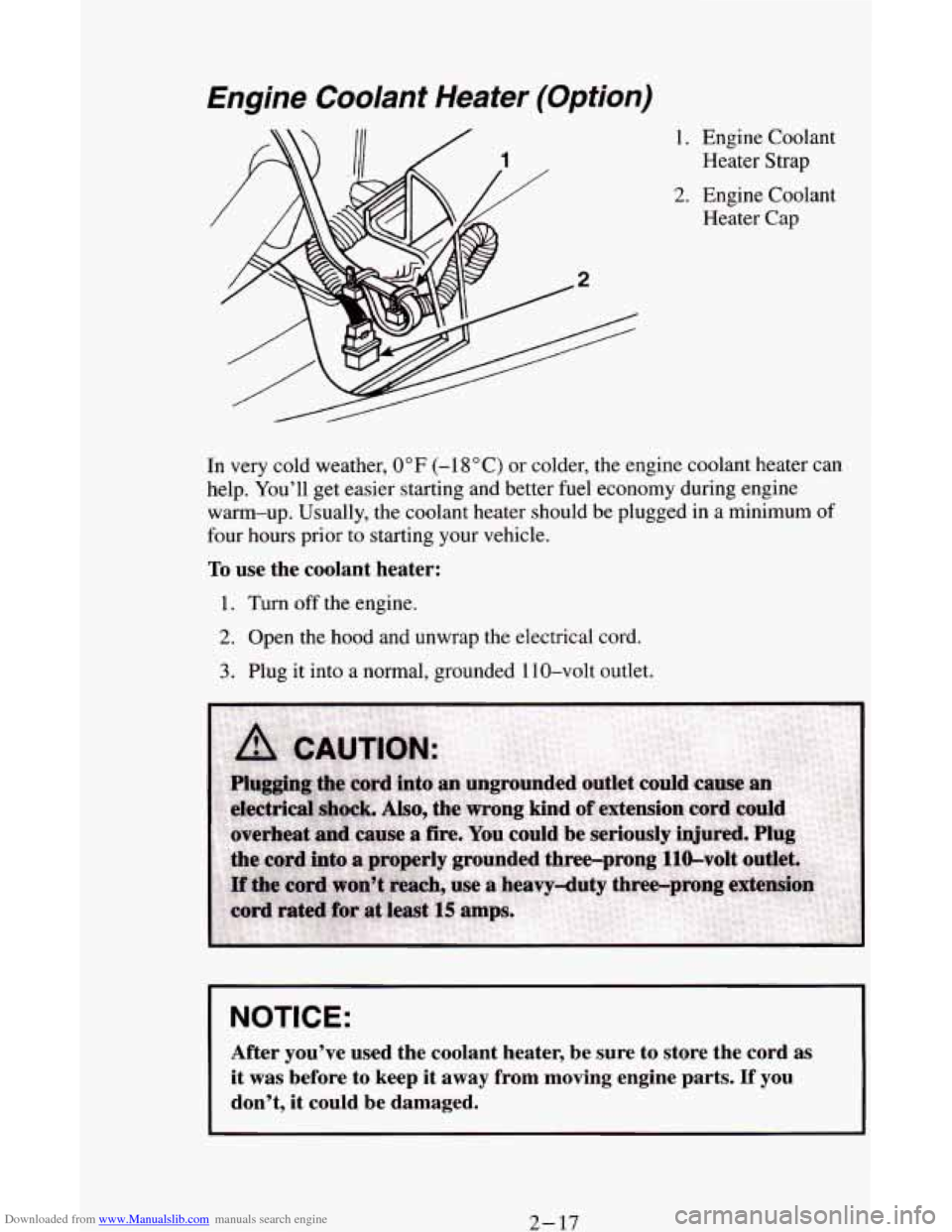
Downloaded from www.Manualslib.com manuals search engine Engine Coolant Heater (Option)
1. Engine Coolant Heater Strap
2. Engine Coolant
Heater Cap
In very cold weather, 0" F (-1 8 O C) or colder, the engine coolant heater can
help. You'll get easier starting and better fuel economy during engine
warm-up. Usually, the coolant heater should be plugged in a minimum
of
four hours prior to starting your vehicle.
To use the coolant heater:
1. Turn off the engine.
2. Open the hood and unwrap the electrical cord.
3. Plug it into a normal, grounded 1 10-volt outlet.
NOTICE:
After you've used the coolant heater, be sure to store the co\
rd as
it was before to keep it away from moving engine parts. If you
don't, it could be damaged.
2-17
Page 72 of 342
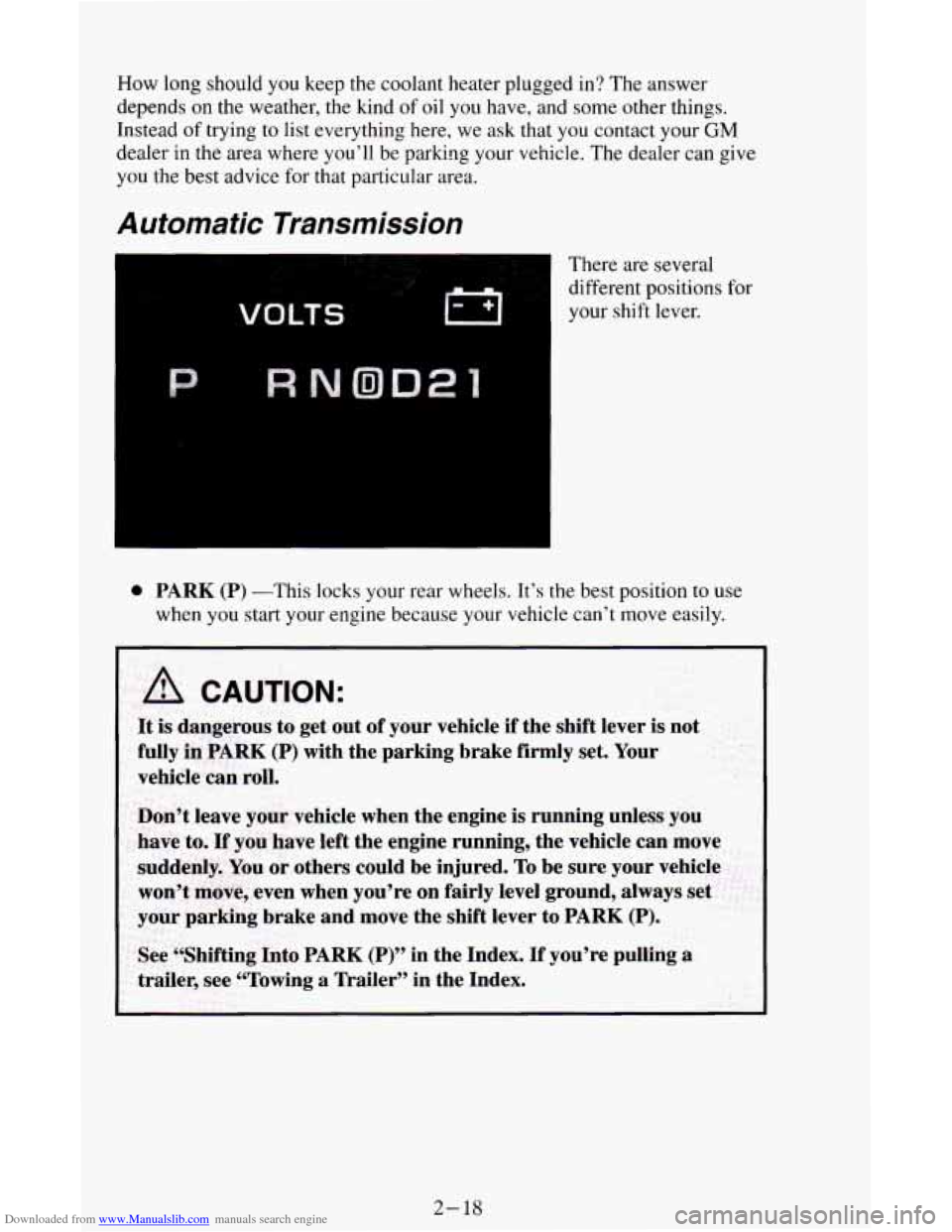
Downloaded from www.Manualslib.com manuals search engine How long should you keep the coolant heater plugged in? The answer
depends
on the weather, the kind of oil you have, and some other things.
Instead
of trying to list everything here, we ask that you contact your GM
dealer in the area where you’ll be parking your vehicle. The dealer can give
you the best advice for that particular area.
Automatic Transmission
There are several
different positions for
your shift lever.
0 PARK (P) -This locks your rear wheels. It’s the best position to use
when you start your engine because your vehicle can’t move easily.
A CAUTION:
It is dangerous to get out of your vehicle if the shift lever is not I
fully in PARK (P) with the parking brake firmly set. Your
vehicle can roll.
Don’t leave your vehicle when the engine is running unless you
have to.
If you have left the engine running, the vehicle can move
suddenly.
You or others could be injured. To be sure your vehicle
won’t move, even when you’re on fairly level ground, always set
your parking brake and move the shift lever to PARK
(P). I
See “Shifting Into PARK (P)” in the Index. If you’re pulling a
trailer,
see “Towing a Trailer” in the Index.
2- 18
Page 103 of 342
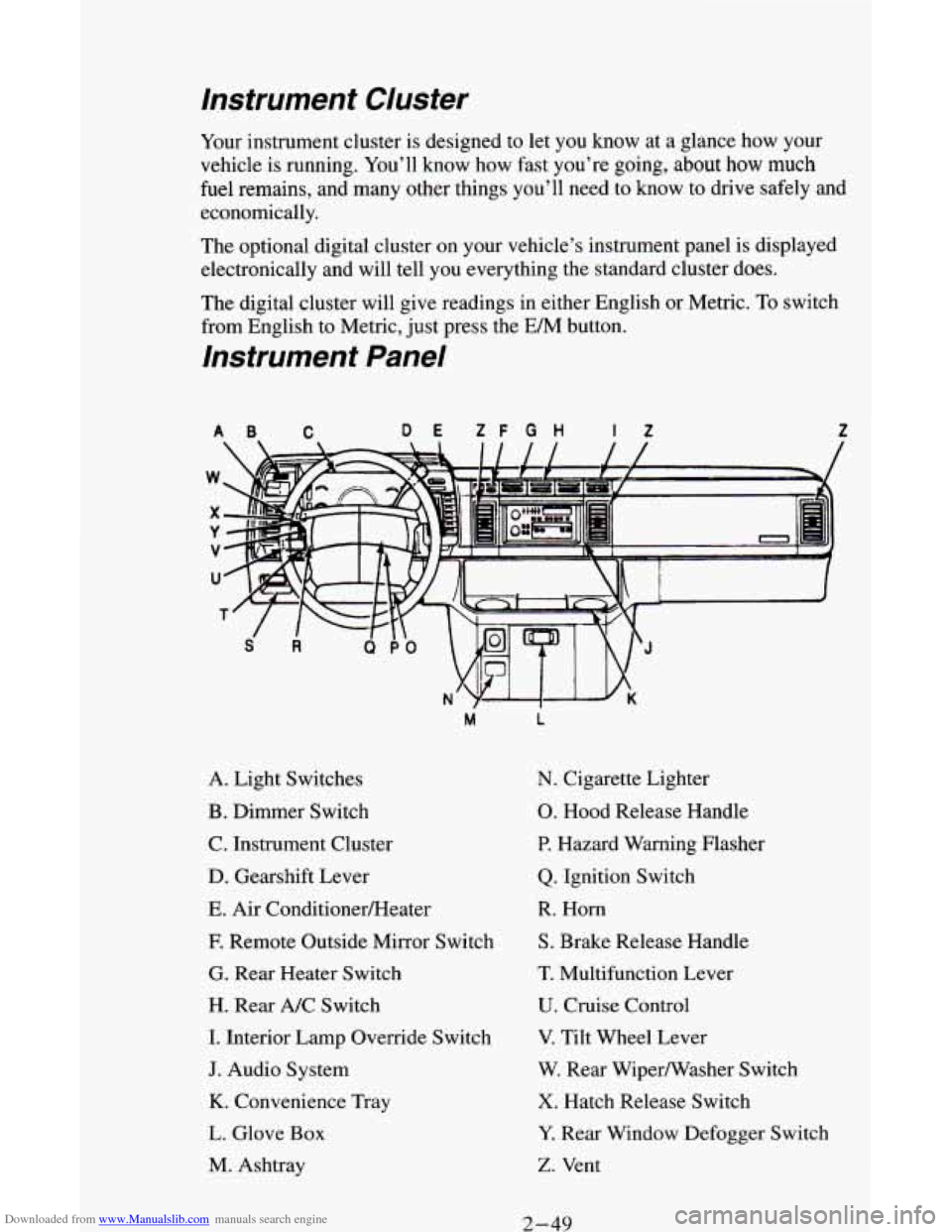
Downloaded from www.Manualslib.com manuals search engine Instrument Cluster
Your instrument cluster is designed to let you know at a glance how your
vehicle is running. You’ll know how fast you’re going, about
how much
fuel remains, and many other things you’ll need to know to drive safely and
economically.
The optional digital cluster on your vehicle’s instrument panel
is displayed
electronically and will tell you everything the standard cluster does.
The digital cluster will give readings in either English or Metric. To switch
from English to Metric, just press the
EM button.
Instrument Panel
AB C DE ZF G H If Z
A. Light Switches
B. Dimmer Switch
C. Instrument Cluster
D. Gearshift Lever
E. Air ConditionerEIeater
E Remote Outside Mirror Switch
G. Rear Heater Switch
H. Rear A/C Switch
I. Interior Lamp Override Switch
J. Audio System
K. Convenience Tray
L. Glove Box
M. Ashtray
M L
N. Cigarette Lighter
0. Hood Release Handle
P. Hazard Warning Flasher
Q. Ignition Switch
R. Horn
S. Brake Release Handle
T. Multifunction Lever
U. Cruise Control
V. Tilt Wheel Lever
W. Rear Wipermasher Switch
X. Hatch Release Switch
Y. Rear Window Defogger Switch
Z. Vent
2-49
Page 119 of 342
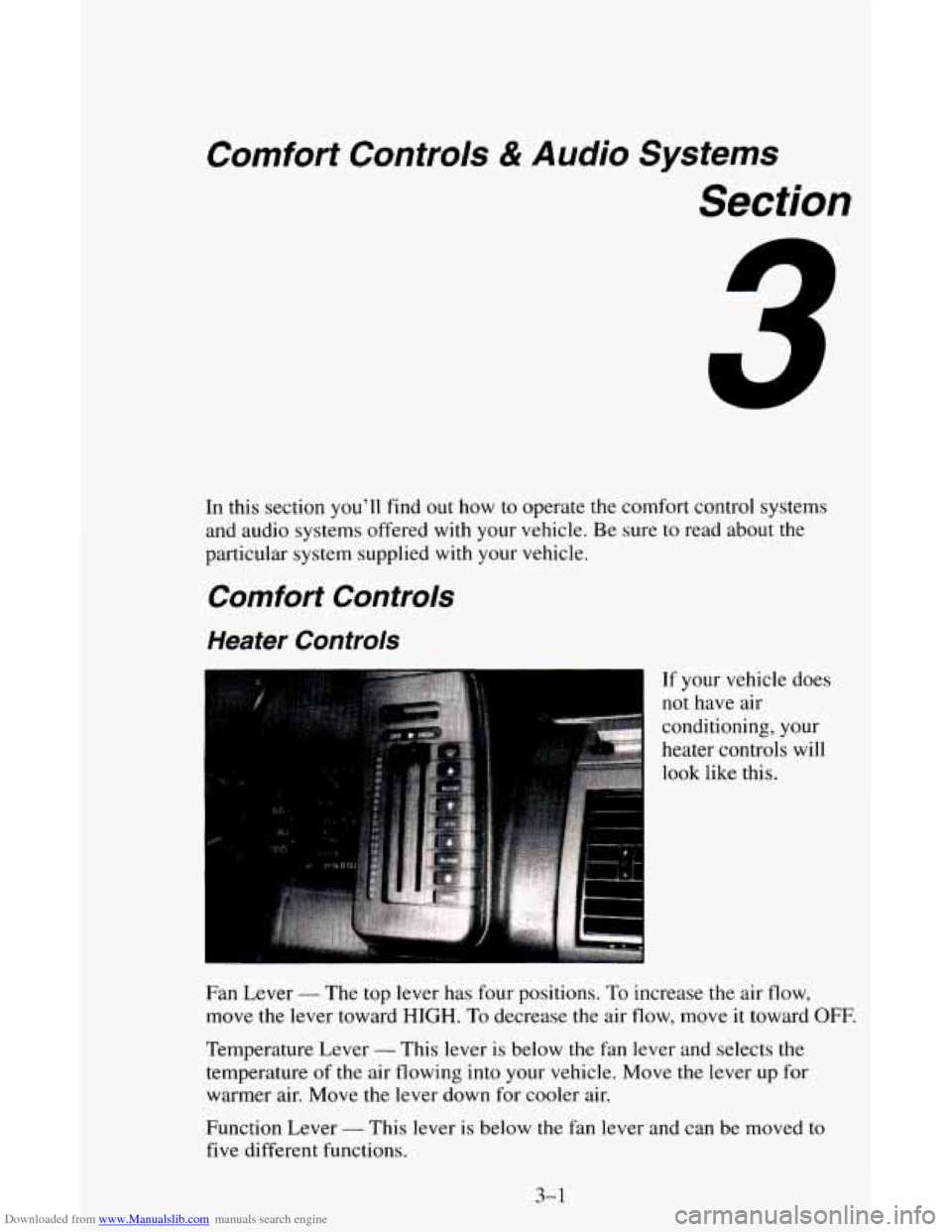
Downloaded from www.Manualslib.com manuals search engine Comfort Controls & Audio Systems
Section
In this section you’ll find out how to operate the comfort control systems
and audio systems offered with your vehicle. Be sure
to read about the
particular system supplied with your vehicle.
Comfort Controls
Heater Controls
If your vehicle does
not have air
conditioning, your
heater controls will
look like this.
Fan Lever
- The top lever has four positions. To increase the air flow,
move the lever toward
HIGH. To decrease the air flow, move it toward OFF.
Temperature Lever - This lever is below the fan lever and selects the
temperature
of the air flowing into your vehicle. Move the lever up for
warmer air. Move the lever down for cooler air.
Function Lever
- This lever is below the fan lever and can be moved to
five different functions.
3-1
Page 120 of 342
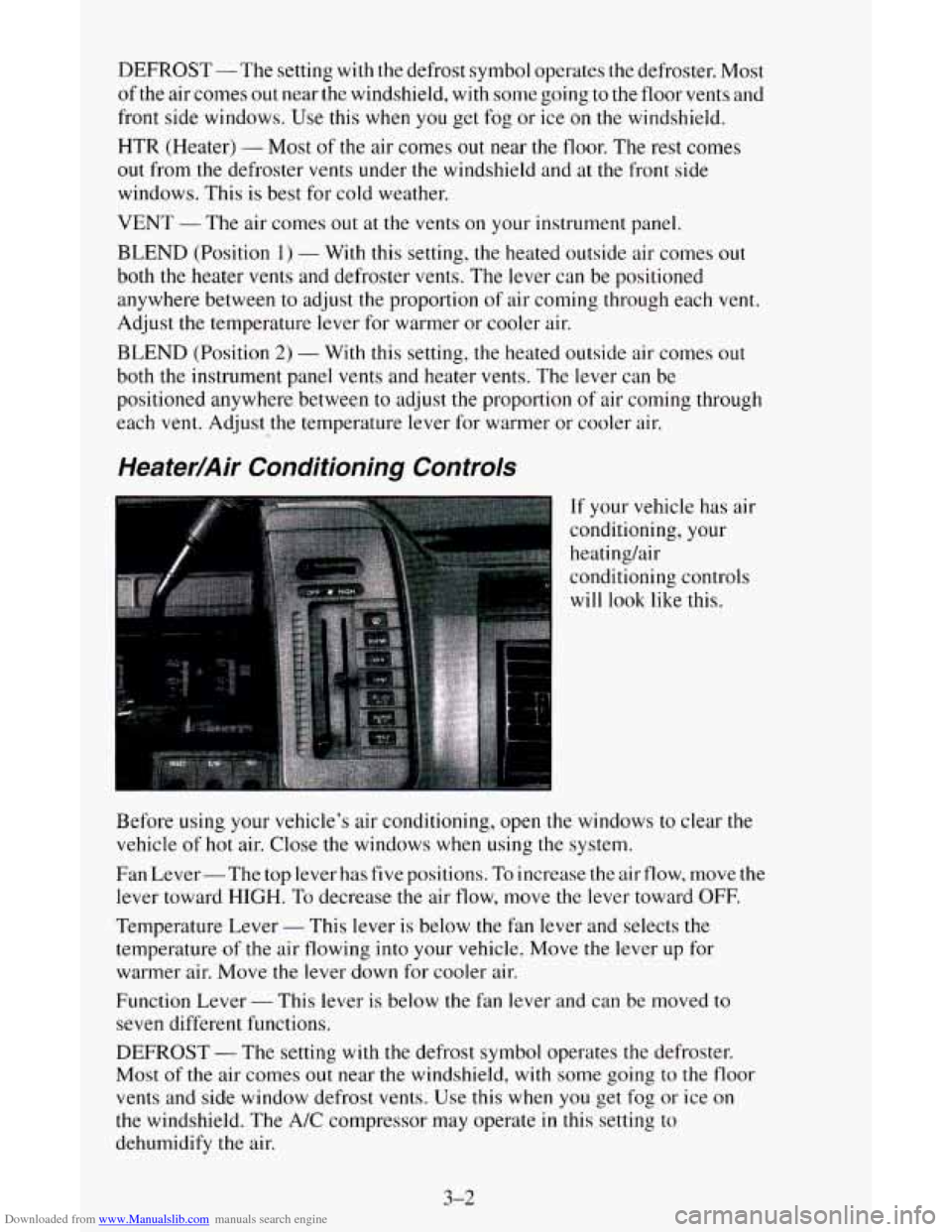
Downloaded from www.Manualslib.com manuals search engine DEFROST-The setting with the defrost symbol operates the defroster. Most
of the air comes out near the windshield, with some going to the floor vents and
front side windows. Use
this when you get fog or ice on the windshield.
HTR (Heater) - Most of the air comes out near the floor. The rest comes
out from the defroster
vents under the windshield and at the front side
windows. This is best for cold weather.
VENT
- The air comes out at the vents on your instrument panel.
BLEND (Position
1) - With this setting, the heated outside air comes out
both
the heater vents and defroster vents. The lever can be positioned
anywhere between to adjust the proportion of air coming through each
vent.
Adjust the temperature lever for warmer or cooler air.
BLEND (Position
2) - With this setting, the heated outside air comes out
both the instrument panel vents and heater vents. The lever can be
positioned anywhere between
to adjust the proportion of air coming through
each
vent. Adjust the temperature lever for warmer or cooler air.
Heater/Air Conditioning Controls
If your vehicle has air
conditioning, your
heatinghir
conditioning controls
will
look like this.
Before using your vehicle’s air conditioning, open the windows to clear the
vehicle
of hot air. Close the windows when using the system.
Fan Lever- The top lever has five positions.
To increase the air flow, move the
lever toward
HIGH. To decrease the air flow, move the lever toward OFF.
Temperature Lever
- This lever is below the fan lever and selects the
temperature of the air flowing into your vehicle. Move the lever up for
warmer air. Move the lever down for cooler air.
Function Lever
- This lever is below the fan lever and can be moved to
seven different functions.
DEFROST
- The setting with the defrost symbol operates the defroster.
Most of the air comes out near the windshield,
with some going to the floor
vents and side window defrost vents. Use this when you get fog or ice on
the windshield. The A/C compressor may operate in this setting to
dehumidify the air.
3-2
Page 121 of 342
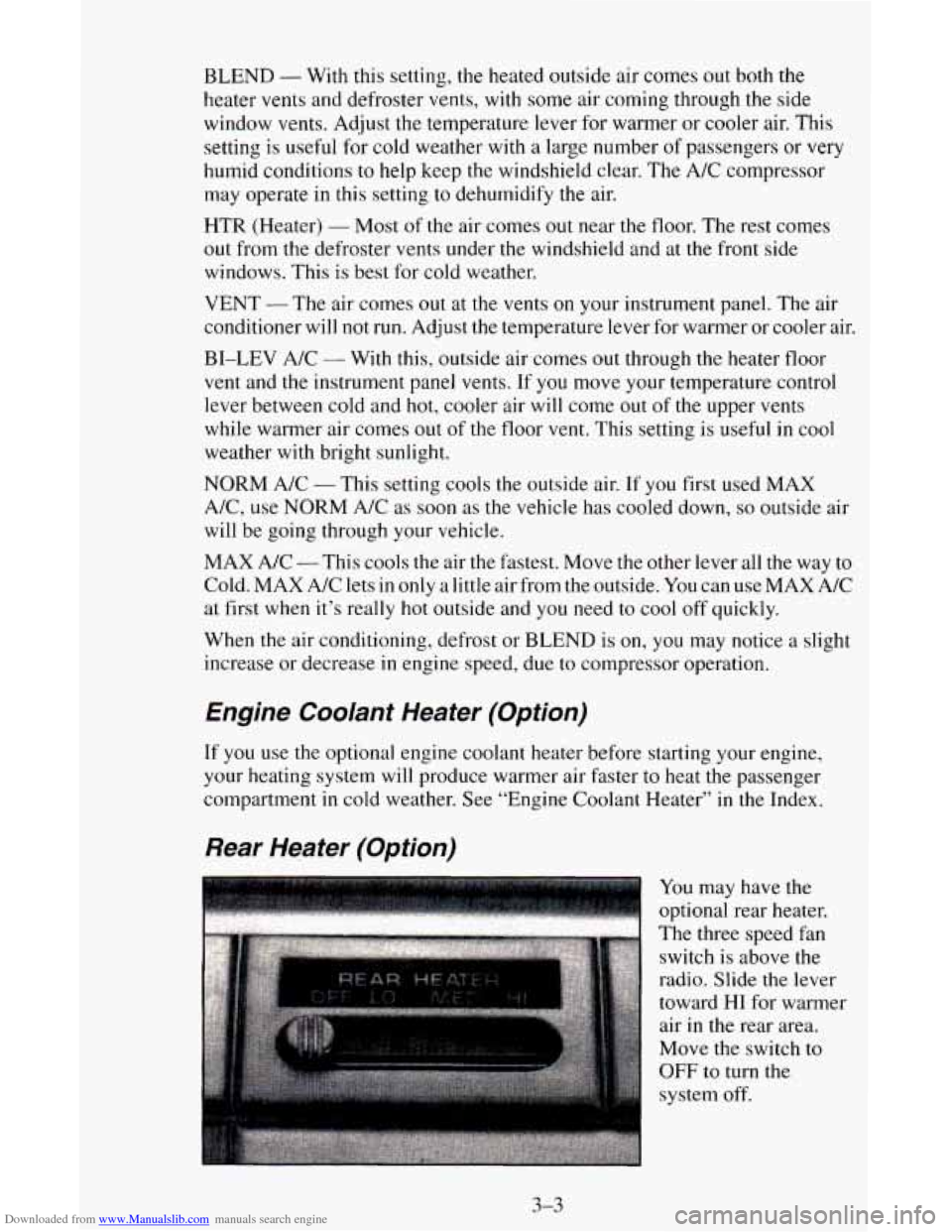
Downloaded from www.Manualslib.com manuals search engine BLEND - With this setting, the heated outside air comes out both the
heater
vents and defroster vents, with some air coming through the side
window vents. Adjust the temperature lever
for warmer or cooler air. This
setting
is useful for cold weather with a large number of passengers or very
humid conditions
to help keep the windshield clear. The A/C compressor
may operate in this setting
to dehumidify the air.
HTR (Heater)
- Most of the air comes out near the floor. The rest comes
out from the defroster vents under the windshield and at the front side
windows. This
is best for cold weather.
VENT
- The air comes out at the vents on your instrument panel. The air
conditioner will not run. Adjust the temperature lever for warmer or cooler air.
BI-LEV A/C - With this, outside air comes out through the heater floor
vent and the instrument panel vents. If you move your temperature control
lever between cold and hot, cooler air
will come out of the upper vents
while warmer air comes
out of the floor vent. This setting is useful in cool
weather with bright sunlight.
NORM A/C - This setting cools the outside air. If you first used MAX
A/C, use NORM A/C
as soon as the vehicle has cooled down, so outside air
will be going through your vehicle.
MAX A/C -This cools the air the fastest. Move
the other lever all the way to
Cold. MAX A/C lets in only a little air from the outside. You can use MAX A/C
at first when
it's really hot outside and you need to cool off quickly.
When
the air conditioning, defrost or BLEND is on, you may notice a slight
increase or decrease in engine speed, due
to compressor operation.
Engine Coolant Heater (Option)
If you use the optional engine coolant heater before starting your engine,
your heating system will produce warmer air faster to heat the passenger
compartment
in cold weather. See "Engine Coolant Heater" in the Index.
Rear Heater (Option)
You may have the
optional rear heater.
The three speed fan
switch is above the
radio. Slide
the lever
toward
HI for warmer
air in the rear area.
Move the switch to
OFF to turn the
system off.
3-3
Page 123 of 342
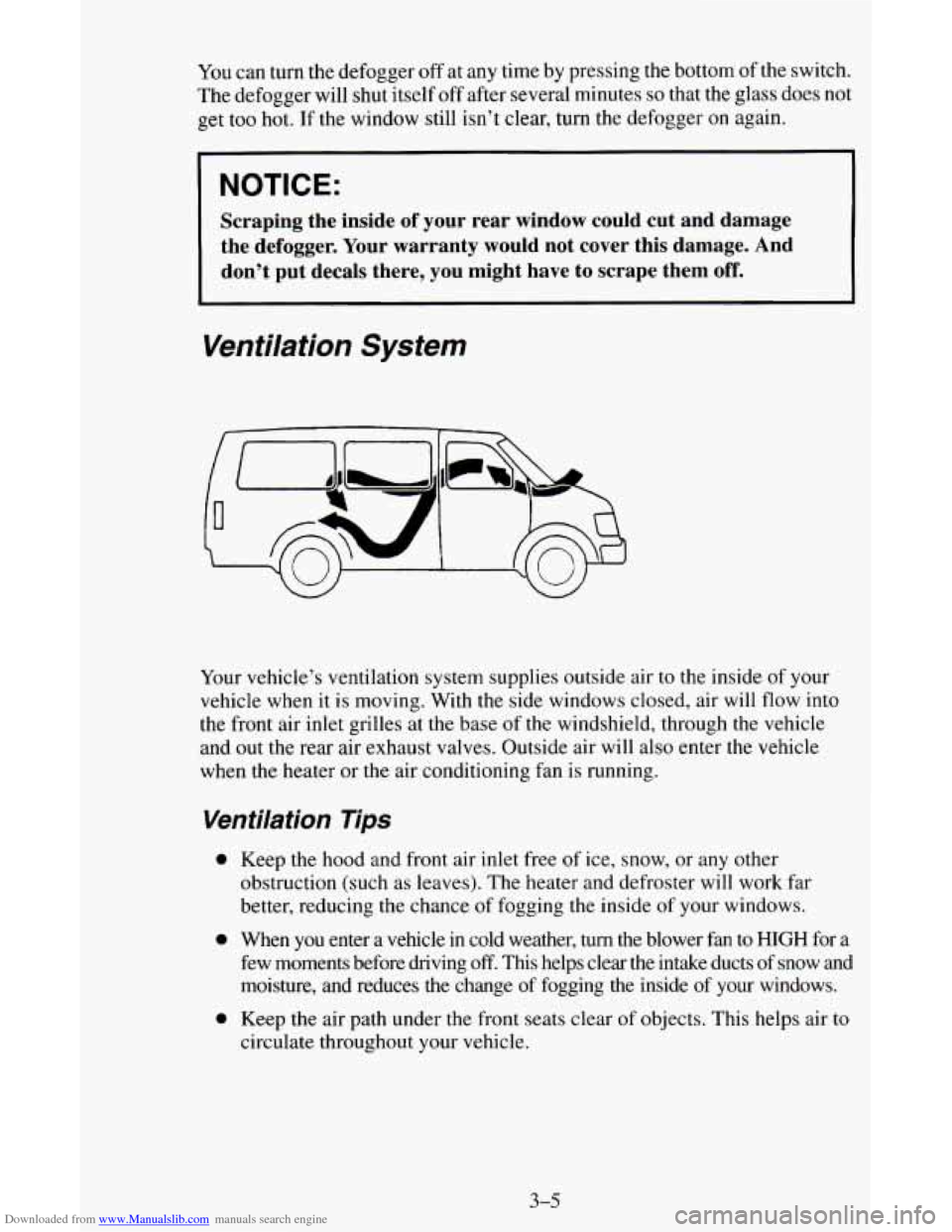
Downloaded from www.Manualslib.com manuals search engine You can turn the defogger off at any time by pressing the bottom of the switch.
The defogger will shut itself off after several minutes
so that the glass does not
get too hot. If the window still isn’t clear, turn the defogger on again.
NOTICE:
Scraping the inside of your rear window could cut and damage
the defogger. Your warranty would not cover this damage. And
don’t put decals there, you might have to scrape them
off.
Ventilation System
Your vehicle’s ventilation system supplies outside air to the inside of your
vehicle when it is moving. With the side windows closed, air will flow into
the front air inlet grilles at the base of
the windshield, through the vehicle
and out the rear air exhaust valves. Outside air will also enter the vehicle
when the heater or the air conditioning fan is running.
Venfilation Tips
0 Keep the hood and front air inlet free of ice, snow, or any other
obstruction (such as leaves). The heater and defroster will work far
better, reducing the chance of fogging the inside of your windows.
0 When you enter a vehicle in cold weather, turn the blower fan to HIGH for a
few moments before driving
off. This helps clear the intake ducts of snow and
moisture, and reduces the change
of fogging the inside of your windows.
0 Keep the air path under the front seats clear of objects. This helps air to
circulate throughout your vehicle.
3-5
Page 160 of 342
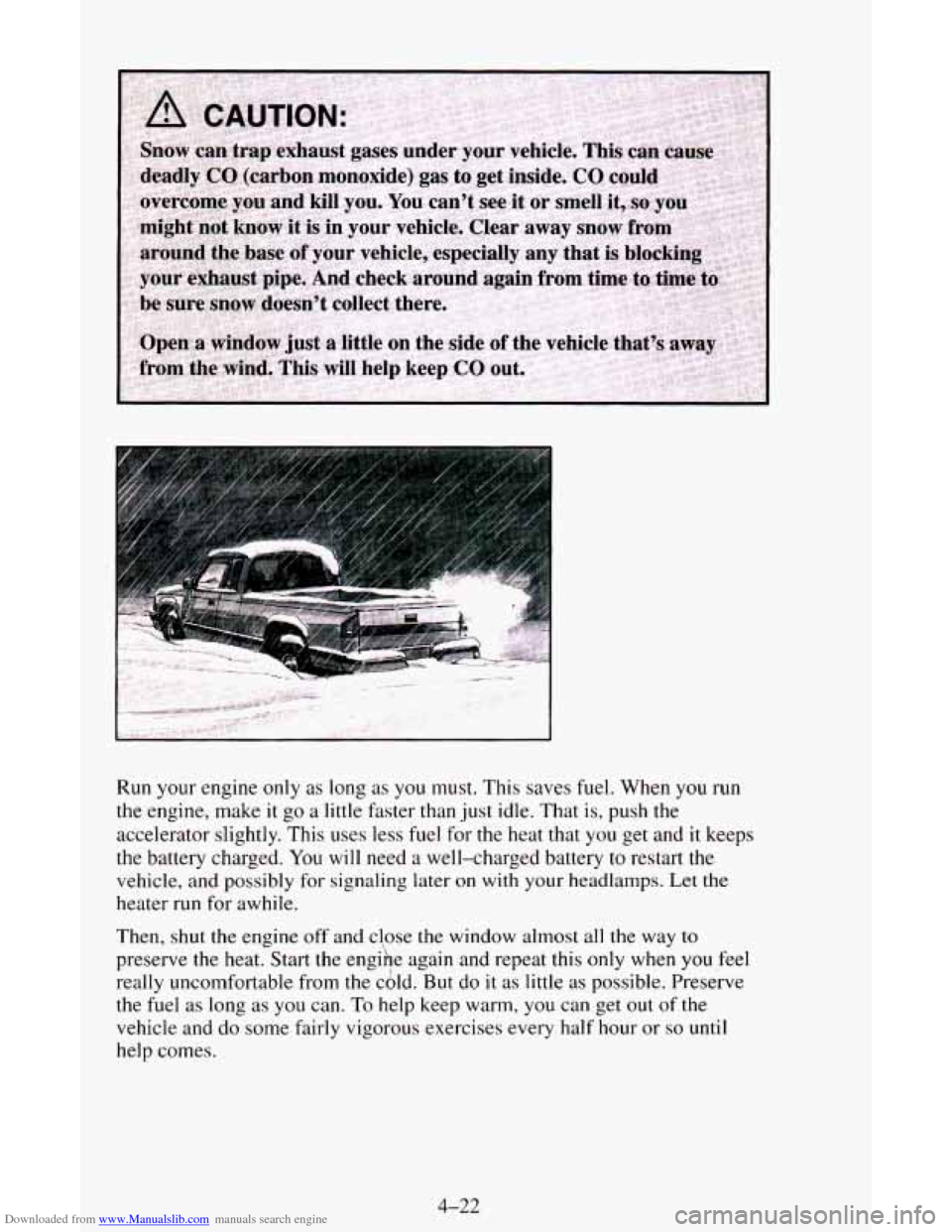
Downloaded from www.Manualslib.com manuals search engine Run your engine only as long as you must. This saves fuel. When you run
the engine, make it go a little faster than just idle. That is, push the
accelerator slightly. This uses less
fuel for the heat that you get and it keeps
the battery charged.
You will need a well-charged battery to restart the
vehicle, and possibly for signaling later on
with your headlarnps. Let the
heater run for awhile.
Then,
shut the engine off and close the window almost all the way to
preserve the heat. Start the engihe again and repeat this only when
you feel
really uncomfortable from the cbld. But do
it as little as possible. Preserve
the fuel as long as
you can. To help keep warm, you can get out of the
vehicle and do some fairly vigorous exercises every half hour or
so until
help comes.
4-22